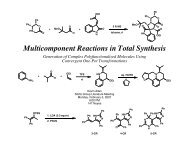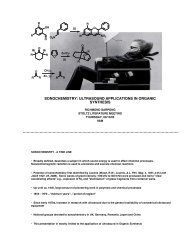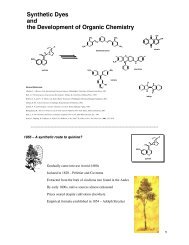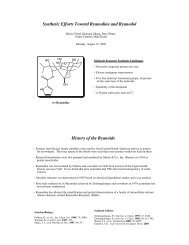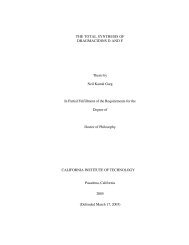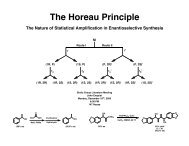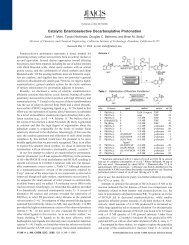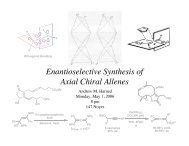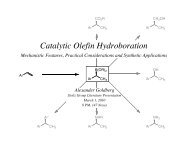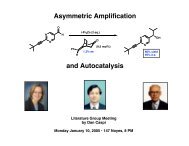The Horeau Principle - The Stoltz Group
The Horeau Principle - The Stoltz Group
The Horeau Principle - The Stoltz Group
Create successful ePaper yourself
Turn your PDF publications into a flip-book with our unique Google optimized e-Paper software.
<strong>The</strong> <strong>Horeau</strong> <strong>Principle</strong><br />
<strong>The</strong> Nature of Statistical Amplification in Enantioselective Synthesis<br />
M<br />
Route I<br />
Route II<br />
r<br />
r'<br />
(1R, P) (1S, P) (P, 2R)' (P, 2S)'<br />
r α<br />
r β<br />
r α<br />
' r β<br />
'<br />
(1R, 2R) (1R, 2S) (1S, 2R) (1S, 2S) (1R, 2R)' (1S, 2R)' (1R, 2S)' (1S, 2S)'<br />
<strong>Stoltz</strong> <strong>Group</strong> Literature Meeting<br />
John Enquist<br />
Monday, December 18 th , 2006<br />
8:00 PM<br />
147 Noyes<br />
OH<br />
O<br />
EtO OEt<br />
NaH, PhMe<br />
Purification<br />
Hydrolysis<br />
OH<br />
O<br />
O<br />
OH<br />
SnBu 3<br />
Pd(PPh 3 ) 4 , CuCl<br />
CuCl 2 , DMSO, 60 °C<br />
O<br />
O<br />
OH<br />
OH<br />
O<br />
O<br />
(60% ee)<br />
(86.5% ee)<br />
88% ee 82% yield<br />
8 : 1 dr<br />
(99.2% ee)
<strong>The</strong> <strong>Horeau</strong> <strong>Principle</strong>: A Statistical Basis for Asymmetric Amplification<br />
I.) Origins and explanation of the <strong>Horeau</strong> <strong>Principle</strong>.<br />
A.) Wolfgang Langenback's observations.<br />
B.) <strong>Horeau</strong>'s original experiments and conclusions.<br />
C.) Critical assumptions, costs, and guiding concepts of <strong>Horeau</strong>'s work.<br />
II.) <strong>The</strong> <strong>Horeau</strong> <strong>Principle</strong> via chemical duplication.<br />
A.) Duplication as a method of chiral resolution or enantioenrichment.<br />
B.) Applications of duplication to the elucidation of substrate ee.<br />
C.) Duplications and their application to synthesis.<br />
III.) Extensions of the <strong>Horeau</strong> <strong>Principle</strong> beyond duplication.<br />
A.) <strong>The</strong> <strong>Horeau</strong> <strong>Principle</strong> via multiple enantioselective catalysis.<br />
B.) Adding complexity to the <strong>Horeau</strong> <strong>Principle</strong>.<br />
IV.) Conclusions.<br />
Reviews:<br />
Duplication and purification - Jacques, J.; Collet, A.; Wilen, S. H. Enantiomers, Racemates and Resolution, 1981, p. 430-434.<br />
<strong>The</strong> <strong>Horeau</strong> <strong>Principle</strong> explained - Rautenstrauch, V. Bull. Soc. Chim. Fr. 1994, 131, 515-524.<br />
Double Asymmetric synthesis - Baba, S. E.; Sartor, K.; Poulin, J.; Kagan, H. Bull. Soc. Chim. Fr. 1994, 131, 525-533.<br />
In the context of non-linear effects - Girard, C.; Kagan, H. Angew. Chem. Int. Ed. 1998, 37, 2922-2959.<br />
<strong>The</strong> historical perspective - Heller, G. Angew. Chem. Int. Ed. 2000, 39, 495-499.<br />
Mathematical treatment and assumptions - Chandrasekhar, S. 2005, 31, 779-783.
Langenback's Observations: <strong>The</strong> Origin of the <strong>Horeau</strong> <strong>Principle</strong><br />
An Idea Before its Time<br />
• Langenback's original publication in 1936 postulated:<br />
"With every synthesis of an optically active compound from inactive starting materials, a degredation in optical purity<br />
takes place... <strong>The</strong> infinite repetition of these processes over a geological time period would have led to a complete<br />
loss of optical activity... if the degredation were not compensated for by an increase in optical purity in a different<br />
process."<br />
• To understand and indentify this phenomenon, Langenback investigated a simple dimerization process:<br />
O<br />
O<br />
2<br />
OH<br />
Cl<br />
O<br />
Cl<br />
O<br />
O<br />
O<br />
2 HCl<br />
L – menthol<br />
(0 - 100% ee)<br />
• Analysis of the optical rotation of the product bis-ester revealed<br />
unusal behavior. Product rotation varied as a function of the<br />
ee of L-menthol.<br />
• No stereocenters were formed... What factors influence optical<br />
rotation here?<br />
Heller, G. Angew. Chem. Int. Ed. 2000, 39, 495-499.<br />
Langenbeck, W. Z. Phys. Chem. A 1936, 177, 401-408.
Langenback's Observations: <strong>The</strong> Origin of the <strong>Horeau</strong> <strong>Principle</strong><br />
An Idea Before its Time<br />
• Reaction between scalemic l-menthol and oxalyl chloride is expected to<br />
produce both homochiral and heterochiral diastereomers. <strong>The</strong> homochiral<br />
product is afforded as a pair of enantiomers. <strong>The</strong> heterochiral product is meso.<br />
OH<br />
Cl<br />
O<br />
O<br />
Cl<br />
k l-mono<br />
O<br />
O<br />
O<br />
Cl<br />
k l,l<br />
k l,d<br />
O<br />
O<br />
O<br />
O<br />
(l,l)-bismenthyl<br />
oxylate<br />
"If it were possible to separate the meso ester quantitatively, then<br />
it would be expected that even with the use of l-menthol with a low<br />
ee value, an increase in the optical purity of the product would be<br />
observed."<br />
O<br />
O<br />
O<br />
O<br />
(l,d)-bismenthyl<br />
oxylate<br />
OH<br />
Cl<br />
O<br />
O<br />
Cl<br />
k d-mono<br />
O<br />
O<br />
O<br />
Cl<br />
k d,l<br />
k d,d<br />
O<br />
O<br />
O<br />
O<br />
(d,l)-bismenthyl<br />
oxylate<br />
O<br />
O<br />
O<br />
O<br />
(d,d)-bismenthyl<br />
oxylate<br />
Heller, G. Angew. Chem. Int. Ed. 2000, 39, 495-499.<br />
Langenbeck, W. Z. Phys. Chem. A 1936, 177, 401-408.
<strong>Horeau</strong>'s Experiments: Statistical Enantiomeric Enrichment<br />
Dimerization as a Resolution Technique<br />
• In 1973, <strong>Horeau</strong> performed experiments very similar to Langenbeck's duplications, but with the aid of separation techniques.<br />
O<br />
O<br />
EtO OEt<br />
OH O O<br />
NaH, PhMe<br />
O<br />
O<br />
O<br />
(60% ee)<br />
Homochiral<br />
Heterochiral<br />
2.10 :<br />
1<br />
• Dimerization of a nonracemic molecule through<br />
an achiral linker provided a mixture of<br />
diastereomeric products.<br />
• Separation of these diastereomers followed<br />
by liberation of the monomers yielded two<br />
different mixtures of the starting material.<br />
• <strong>The</strong> homochiral diastereomer afforded<br />
enantioenriched monomer, whereas the<br />
heterochiral diastereomer afforded only<br />
racemic monomer.<br />
Hydrolysis<br />
OH<br />
Hydrolysis<br />
OH<br />
67.7% yield<br />
(86.5% ee)<br />
32.2% yield<br />
(0% ee)<br />
Vigneron, J. P.; Dhaenes, M.; <strong>Horeau</strong>, A. Tetrahedron, 1973, 29, 1055-1059.<br />
Rautenstrauch, V. Bull. Soc. Chim. Fr. 1994, 131, 515-524.
<strong>Horeau</strong>'s Experiments: Statistical Enantiomeric Enrichment<br />
Math and <strong>The</strong>ory<br />
• For any scalemic mixture composed of molecules baring a single chiral center, the respective enantiomers are represented<br />
by the letters R and S. An achiral, bifunctional duplication reagent is represented by A.<br />
• If the scalemic mixture is enriched with the R enantiomer,<br />
the total composition of R in the mixture can be represented as<br />
x, while the total composition of S is 1-x (where R+S=1).<br />
• Criticial Assumptions:<br />
- <strong>The</strong> outcome of the first reaction must have no influence<br />
upon the second reaction. This means no chiral recognition<br />
between RA or SA and either incoming monomer.<br />
- <strong>The</strong>re must be no difference in rate between enantiomers<br />
during the formation of RA or SA.<br />
- <strong>The</strong>re must be no interference by side reactions.<br />
- Reactions must be irreversible.<br />
• Following the above assumptions, we can conclude:<br />
R<br />
x<br />
S<br />
(1-x)<br />
k m<br />
A<br />
A<br />
k m<br />
RA<br />
x<br />
SA<br />
(1-x)<br />
R<br />
S<br />
R<br />
S<br />
k d<br />
k d<br />
k d<br />
k d<br />
RR<br />
RS<br />
SR<br />
SS<br />
x 2<br />
x•(1-x)<br />
(1-x)•x<br />
(1-x) 2<br />
ee p =<br />
Homochiral Yield<br />
dr = =<br />
er p =<br />
Heterochiral Yield<br />
RR – SS<br />
RR + SS<br />
=<br />
x 2 – (1-x) 2<br />
x 2 + (1-x) 2<br />
RR<br />
SS = x 2<br />
(1-x) = x<br />
2 (1-x)<br />
x 2 + (1-x) 2<br />
2•x•(1-x)<br />
2<br />
excess of the starting material, we can find alternative<br />
expressions for ee p and dr:<br />
• If we take the value ee i to be the initial enantiomeric<br />
2•ee<br />
= (er i ) 2 ee p = i<br />
1 + (ee<br />
dr =<br />
i ) 2<br />
1 + (ee i ) 2 1 – (ee i ) 2<br />
Vigneron, J. P.; Dhaenes, M.; <strong>Horeau</strong>, A. Tetrahedron, 1973, 29, 1055-1059.<br />
Rautenstrauch, V. Bull. Soc. Chim. Fr. 1994, 131, 515-524.
<strong>Horeau</strong>'s Experiments: Statistical Enantiomeric Enrichment<br />
Costs and Benefits<br />
• <strong>The</strong> ee of the dimer increases beyond that of the monomer quickly. This is an example of positive nonlinear behavior.<br />
er p = = (er i ) 2<br />
= RR<br />
SS<br />
R<br />
S<br />
2<br />
er p ≥ er i<br />
(for all R > S)<br />
ee p =<br />
2•ee i<br />
1 + (ee i ) 2<br />
• <strong>The</strong> de (and hence dr) of the dimer increases more slowly, with high dr only achieved at large ee i values.<br />
dr =<br />
1 + (ee i ) 2 de = (ee i ) 2 ≤ ee i for 0 ≤ ee i ≤ 1<br />
1 – (ee i ) 2<br />
1<br />
0.9<br />
• <strong>The</strong> inherent cost of this duplication<br />
technique is a loss in yield. <strong>The</strong><br />
removed meso diastereomer is half<br />
composed of the desired enantiomer!<br />
Yield loss =<br />
1<br />
1 + dr<br />
Values • 100%<br />
0.8<br />
0.7<br />
0.6<br />
0.5<br />
0.4<br />
ee of the dimer<br />
de of the dimer<br />
Yield lost<br />
0.3<br />
0.2<br />
Vigneron, J. P.; Dhaenes, M.; <strong>Horeau</strong>, A.<br />
Tetrahedron, 1973, 29, 1055-1059.<br />
Rautenstrauch, V. Bull. Soc. Chim. Fr.<br />
1994, 131, 515-524.<br />
0.1<br />
0<br />
0 0.1 0.2 0.3 0.4 0.5 0.6 0.7 0.8 0.9 1<br />
(ee of the monomer) • 100%
Enantiomeric Enrichment via Duplication<br />
Applications and Synthesis<br />
• Synthesis and enantioenrichment of diisopinocamphenylborane from scalemic (α)-pinene.<br />
B 2 H 6<br />
0 °C<br />
THF<br />
B<br />
H<br />
H<br />
B<br />
2 2<br />
ee i ee p<br />
91.6 99.0<br />
92.0 99.0<br />
ee calc<br />
99.6<br />
99.7<br />
(<strong>Horeau</strong> <strong>Principle</strong> behavior observed despite newly forming chiral center)<br />
84.0 98.3<br />
98.4<br />
B 2 H 6<br />
0 °C<br />
THF<br />
HB<br />
1. 1-Pentene<br />
2. PhCHO<br />
75 °C, neat<br />
(86.3% ee i )<br />
Brown, H. C.; Singaram, B. J. Org. Chem. 1984, 49, 945-947.<br />
Prabhakar, K.; Brown, H. C. J. Org. Chem. 1985, 50, 3203-3206.<br />
2<br />
44% yield<br />
(98.5% ee i )<br />
• Dimerization of (S)-methylbenzylamine was used in order to assay ee without need for a chiral auxiliary.<br />
Ph<br />
(Cl 3 CO) 2 CO<br />
Ph<br />
O<br />
Ph<br />
• 1 H NMR showed 99:1 dr in favor of the<br />
homochiral diastereomer for (+)-methylbenzylamine.<br />
NH 2<br />
NEt 3 , CH 2 Cl 2<br />
NH<br />
N<br />
H<br />
• (±)-methylbenzylamine gave a 1:1 dr.<br />
• <strong>The</strong> amine ee i was determined to be 99.1%<br />
Grotjahn, D.; Joubran, C.; Tetrahedron: Asymmetry 1995, 6, 745-752.
Enantiomeric Enrichment via Duplication<br />
Applications and Synthesis<br />
• Low selectivity carboalumination produced substrates with modest ee values. Duplication made them synthetically useful.<br />
HO<br />
OCN<br />
NCO<br />
PhH, DABCO<br />
60 °C, 4 h<br />
R<br />
O<br />
O<br />
N<br />
H<br />
H<br />
N<br />
O<br />
R<br />
(74% ee i )<br />
Huo, S.; Negishi, E. Org. Lett. 2001, 3, 3253-3256.<br />
43% yield<br />
(no reported dr)<br />
(93.0% ee)<br />
O<br />
Calculated<br />
3.4 : 1 dr<br />
95.6% ee<br />
• <strong>Horeau</strong>–type duplications are most effective when they are transparent to a synthetic route, or else can play a roll in the synthesis.<br />
O<br />
Cl<br />
O<br />
DMAP, Py<br />
O OH<br />
O O<br />
O<br />
O<br />
O<br />
Cl CH 2 Cl 2<br />
O<br />
O O<br />
(80% ee i )<br />
O<br />
87% yield<br />
4.6 : 1 dr<br />
(97.5% ee)<br />
O<br />
Calculated<br />
4.5 : 1 dr<br />
97.6% ee<br />
Dowex 50W<br />
HO<br />
O<br />
OH<br />
70 °C<br />
MeOH / H 2 O<br />
OH<br />
D'Arrigo, P.; Servi, S. J. Org. Chem. 1997, 62, 6394-6396.<br />
82% yield<br />
O<br />
O<br />
OH<br />
N<br />
H<br />
OH<br />
OH<br />
39.1% overall yield<br />
97.5% ee
Enantiomeric Enrichment via Duplication<br />
Duplication without Achiral Linkers<br />
• <strong>The</strong> total synthesis of (–)-Wodeshiol by Corey benefits from <strong>Horeau</strong>-type ee amplification during the key dimerization:<br />
O<br />
O<br />
Br<br />
(R)–CBS catalyst<br />
catechol borane<br />
O<br />
OH<br />
Br<br />
1. t-BuLi,<br />
-78 °C, Et 2 O<br />
O<br />
OH<br />
SnBu 3<br />
O<br />
PhMe / CH 2 Cl 2<br />
O<br />
2. Bu 3 SnCl<br />
O<br />
84% yield<br />
(88% ee i )<br />
84% yield<br />
OH<br />
OH<br />
O<br />
O<br />
SnBu 3<br />
Pd(PPh 3 ) 4 , CuCl<br />
O<br />
O<br />
CuCl 2 , DMSO, 60 °C<br />
O<br />
(88% ee i )<br />
Han, X.; Corey, E. J. Org. Lett. 1999, 1, 1871-1872.<br />
O<br />
82% yield<br />
8.0 : 1 dr<br />
(99.2% ee)<br />
OH<br />
Calculated<br />
7.9 : 1 dr<br />
99.2% ee<br />
• Derivitization and coupling of a common intermediate to boost modest ee:<br />
MeO 2 C<br />
O<br />
H<br />
THF<br />
AcO<br />
OH<br />
R = TMBDS<br />
(80% ee i )<br />
PhO 2 S<br />
Hoffmann, R.; Schopfer, U. Helv. Chim. Acta. 2002, 85, 4424-4441.<br />
OR<br />
n-BuLi<br />
THF<br />
1. Ac 2 O<br />
2. Na/Hg<br />
MeO 2 C<br />
88% yield<br />
(dr not reported)<br />
≥ 98.0% ee<br />
Calculated<br />
4.5 : 1 dr<br />
97.5% ee<br />
OR
Enantiomeric Enrichment via Duplication<br />
Controversy over the Synthesis of Carpenter Bee Hormone<br />
• 1981: Mori and Tanida report the total synthesis of four stereoisomers of 2,8-Dimethyl-1,7-dioxaspiro[5,5]undecane.<br />
O<br />
CO 2 Et<br />
Yeast<br />
OH<br />
CO 2 Et<br />
(92% ee i )<br />
O<br />
O<br />
O<br />
O<br />
(+)-1 (–)-1<br />
O<br />
O<br />
(±)-2<br />
• 1984: Isaksson and coworkers separate the four naturally occuring stereoisomers via liquid chromatography.<br />
<strong>The</strong>ir optical rotation values do not match those of Mori et al. exactly.<br />
[α] 24<br />
Mori Values<br />
Isaksson Values<br />
(+)-1 (–)-1 (+)-2 (–)-2<br />
+ 51.7° - 51.6° – –<br />
+ 44.6° - 44.3° + 44.0° - 44.6°<br />
"We thus conclude that our isolated enantiomers are at least 98% optically pure.<br />
Mori and Tanida reported [larger] specific rotations... although their chiral starting<br />
material was of only 92% ee... <strong>The</strong> reason for this is not clear to us."<br />
• 1986: Mori and Tanida report multiple (re)syntheses of (+)-1 and (-)–1 in response to Isaksson's paper.<br />
"[Isaksson] challenged our higher values, because we employed [starting material] of only 92% ee... Apparently<br />
they thought that [this] should yield (+)-1 of 92% ee."<br />
Mori, K.; Tanida. Tetrahedron, 1981, 37, 3221-3225.<br />
Isaksson, R.; Liljefors, T. J. Chem. Soc. Chem. Commun. 1984, 137-138.<br />
Mori, K.; Watanabe, H. Tetrahedron, 1986, 42, 295-304.
Enantiomeric Enrichment via Duplication<br />
Controversy over the Synthesis of Carpenter Bee Hormone<br />
• 1981, 1986: Total synthesis and reexamination of 2,8-Dimethyl-1,7-dioxaspiro[5,5]undecane by Mori.<br />
O<br />
CO 2 Et<br />
Yeast<br />
OH<br />
CO 2 Et<br />
(92% ee i )<br />
Mitsunobu reaction<br />
and<br />
Further elaboration<br />
OPG<br />
(85% ee i )<br />
I<br />
OPG<br />
O<br />
CO 2 Et<br />
1. NaH, THF<br />
2. BuLi, THF<br />
3.<br />
OPG<br />
(X% ee i )<br />
I<br />
OPG<br />
O<br />
CO 2 Et<br />
1.<br />
(X% ee i )<br />
K 2 CO 3 , Acetone<br />
2. KOH (aq) , MeOH<br />
I<br />
OPG O OPG<br />
<strong>Horeau</strong> Type Duplication<br />
Alcohol<br />
Config.<br />
Experiment<br />
X% ee i [α] 24 % ee p dr<br />
Calculated<br />
% ee p dr<br />
Protecting<br />
<strong>Group</strong><br />
Cleavage<br />
S<br />
92 - 51.6° 99.3 9 : 1<br />
99.6 12 : 1<br />
R<br />
R<br />
100 + 59.2° 100 N/A<br />
85 + 58.7° 97.2 6.4 : 1<br />
100 N/A<br />
98.6 6.2 : 1<br />
O<br />
O<br />
O<br />
O<br />
"In conclusion... the specific rotations reported for 1 and 2 by Isaksson et al. must be in<br />
error. <strong>The</strong> reason for this is not clear to us."<br />
(–)-1<br />
(±)-2<br />
Mori, K.; Tanida. Tetrahedron, 1981, 37, 3221-3225.<br />
Isaksson, R.; Liljefors, T. J. Chem. Soc. Chem. Commun. 1984, 137-138.<br />
Mori, K.; Watanabe, H. Tetrahedron, 1986, 42, 295-304.
Multiple Enantioselective Transformations<br />
Remote Stereocenter Generation and Statistical Distributions<br />
• Do <strong>Horeau</strong>-type distributions and effects play a role in the generation of two or more stereocenters from a prochiral molecule?<br />
- For the case of a molecule M bearing two nonequivalent prochiral centers labeled 1 and 2, we assume total conversion<br />
of the intermediates:<br />
r =<br />
r α<br />
=<br />
r β<br />
=<br />
[1R, P] – [1S, P]<br />
[1R, P] + [1S, P]<br />
[1R, 2R] – [1R, 2S]<br />
[1R, 2R] + [1R, 2S]<br />
[1S, 2R] – [1S, 2S]<br />
[1S, 2R] + [1S, 2S]<br />
1 2<br />
M<br />
n<br />
Route I<br />
Initial Attack at 1<br />
r<br />
(1R)<br />
n<br />
(1S)<br />
n<br />
r α<br />
r β<br />
(1R) n (2R) (1R) n (2S)<br />
(1S) n (2R) (1S) n (2S)<br />
(1R, 2R)<br />
(1R, 2S) (1S, 2R) (1S, 2S)<br />
Baba, S.; Sartor, K.; Kagan, H. Bull. Soc. Chim. Fr. 1994, 525-533.<br />
(1R, 2R) + (1S, 2S) – Diastereomer A<br />
(1R, 2S) + (1S, 2R) – Diastereomer B
Multiple Enantioselective Transformations<br />
Remote Stereocenter Generation and Statistical Distributions<br />
• Do <strong>Horeau</strong>-type distributions and effects play a role in the generation of two or more stereocenters from a prochiral molecule?<br />
- For the case of a molecule M bearing two nonequivalent prochiral centers labeled 1 and 2, we assume total conversion<br />
of the intermediates:<br />
r =<br />
r α<br />
=<br />
[1R, P] – [1S, P]<br />
[1R, P] + [1S, P]<br />
[1R, 2R] – [1R, 2S]<br />
[1R, 2R] + [1R, 2S]<br />
1 2<br />
M<br />
n<br />
Route II<br />
Initial Attack at 2<br />
r' =<br />
r α<br />
' =<br />
[P, 2R]' – [P, 2S]'<br />
[P, 2R]' + [P, 2S]'<br />
[1R, 2R]' – [1S, 2R]'<br />
[1R, 2R]' + [1S, 2R]'<br />
r β<br />
=<br />
[1S, 2R] – [1S, 2S]<br />
[1S, 2R] + [1S, 2S]<br />
r'<br />
r β<br />
' =<br />
[1R, 2S]' – [1S, 2S]'<br />
[1R, 2S]' + [1S, 2S]'<br />
n<br />
(2R)'<br />
n<br />
(2S)'<br />
r α<br />
'<br />
r β<br />
'<br />
(1R)' n (2R)' (1R)' n (2S)'<br />
(1S)' n (2R)' (1S)' n (2S)'<br />
(1R, 2R)'<br />
(1R, 2S)' (1S, 2R)' (1S, 2S)'<br />
Baba, S.; Sartor, K.; Kagan, H. Bull. Soc. Chim. Fr. 1994, 525-533.<br />
(1R, 2R)' + (1S, 2S)' – Diastereomer A<br />
(1R, 2S)' + (1S, 2R)' – Diastereomer B
Multiple Enantioselective Transformations<br />
Remote Stereocenter Generation and Statistical Distributions<br />
• Do <strong>Horeau</strong>-type distributions and effects play a role in the generation of two or more stereocenters from a prochiral molecule?<br />
- For the case of a molecule M bearing two nonequivalent prochiral centers labeled 1 and 2, we assume total conversion<br />
of the intermediates:<br />
r =<br />
r α<br />
=<br />
[1R, P] – [1S, P]<br />
[1R, P] + [1S, P]<br />
[1R, 2R] – [1R, 2S]<br />
[1R, 2R] + [1R, 2S]<br />
R<br />
1 2<br />
M<br />
n<br />
R'<br />
Route I<br />
Route II<br />
r' =<br />
r α<br />
'<br />
=<br />
[P, 2R]' – [P, 2S]'<br />
[P, 2R]' + [P, 2S]'<br />
[1R, 2R]' – [1S, 2R]'<br />
[1R, 2R]' + [1S, 2R]'<br />
r β<br />
=<br />
[1S, 2R] – [1S, 2S]<br />
[1S, 2R] + [1S, 2S]<br />
r<br />
r'<br />
r β<br />
' =<br />
[1R, 2S]' – [1S, 2S]'<br />
[1R, 2S]' + [1S, 2S]'<br />
(1R, P) (1S, P) (P, 2R)' (P, 2S)'<br />
r α<br />
r β<br />
r α<br />
'<br />
r β<br />
'<br />
(1R, 2R) (1R, 2S) (1S, 2R) (1S, 2S) (1R, 2R)' (1S, 2R)' (1R, 2S)' (1S, 2S)'<br />
Diastereomer A = a<br />
Diastereomer B = b<br />
• Additional definitions for the diastereomeric ratio, and a term ( i ) to weigh the relative contributions of Routes I and II:<br />
a<br />
dr = such that a + b =1<br />
b<br />
Baba, S.; Sartor, K.; Kagan, H. Bull. Soc. Chim. Fr. 1994, 525-533.<br />
i =<br />
[1R, P] + [1S, P]<br />
[1R, P] + [1S,P] + [P, 2R]' + [P, 2S]'
Multiple Enantioselective Transformations<br />
Remote Stereocenter Generation and Statistical Distributions<br />
• Do <strong>Horeau</strong>-type distributions and effects play a role in the generation of two or more stereocenters from a prochiral molecule?<br />
- For the case of a molecule M bearing two nonequivalent prochiral centers labeled 1 and 2, we assume total conversion<br />
of the intermediates:<br />
r =<br />
r α<br />
=<br />
[1R, P] – [1S, P]<br />
[1R, P] + [1S, P]<br />
[1R, 2R] – [1R, 2S]<br />
[1R, 2R] + [1R, 2S]<br />
R<br />
1 2<br />
M<br />
n<br />
R'<br />
Route I<br />
Route II<br />
r' =<br />
r α<br />
'<br />
=<br />
[P, 2R]' – [P, 2S]'<br />
[P, 2R]' + [P, 2S]'<br />
[1R, 2R]' – [1S, 2R]'<br />
[1R, 2R]' + [1S, 2R]'<br />
r β<br />
=<br />
[1S, 2R] – [1S, 2S]<br />
[1S, 2R] + [1S, 2S]<br />
r<br />
r'<br />
r β<br />
' =<br />
[1R, 2S]' – [1S, 2S]'<br />
[1R, 2S]' + [1S, 2S]'<br />
(1R, P) (1S, P) (P, 2R)' (P, 2S)'<br />
r α<br />
r β<br />
r α<br />
'<br />
r β<br />
'<br />
(1R, 2R) (1R, 2S) (1S, 2R) (1S, 2S) (1R, 2R)' (1S, 2R)' (1R, 2S)' (1S, 2S)'<br />
• If the possibility for different stereoselectivities at each step is considered, the product ee and dr can be expressed as:<br />
ee A =<br />
([1R, 2R]+[1R, 2R]') – ([1S, 2S]+[1S, 2S]')<br />
([1R, 2R]+[1R, 2R]') + ([1S, 2S]+[1S, 2S]')<br />
=<br />
i [(1+r α<br />
)(1+r) – (1-r β<br />
)(1-r)] + (1-i) [(1+r α<br />
')(1+r') – (1-r β<br />
')(1-r')]<br />
i [(1+r α<br />
)(1+r) + (1-r β<br />
)(1-r)] + (1-i) [(1+r α<br />
')(1+r') + (1-r β<br />
')(1-r')]<br />
ee B =<br />
([1R, 2S]+[1R, 2S]') – ([1S, 2R]+[1S, 2R]')<br />
([1R, 2S]+[1R, 2S]') + ([1S, 2R]+[1S, 2R]')<br />
=<br />
i [(1-r α<br />
)(1+r) – (1-r β<br />
)(1-r)] + (1-i) [(1+r β<br />
')(1-r') – (1-r α<br />
')(1+r')]<br />
i [(1-r α<br />
)(1+r) + (1+r β<br />
)(1-r)] + (1-i) [(1+r β<br />
')(1-r') + (1-r α<br />
')(1+r')]<br />
dr =<br />
([1R, 2R]+[1R, 2R]') + ([1S, 2S]+[1S, 2S]')<br />
([1R, 2S]+[1R, 2S]') + ([1S, 2R]+[1S, 2R]')<br />
=<br />
i [(1+r α<br />
)(1+r) + (1-r β<br />
)(1-r)] + (1-i) [(1+r β<br />
')(1+r') + (1-r α<br />
')(1-r')]<br />
i [(1-r α<br />
)(1+r) + (1+r β<br />
)(1-r)] + (1-i) [(1+r β<br />
')(1-r') + (1-r α<br />
')(1+r')]<br />
Baba, S.; Sartor, K.; Kagan, H. Bull. Soc. Chim. Fr. 1994, 525-533.
Multiple Enantioselective Transformations<br />
Remote Stereocenter Generation and Statistical Distributions<br />
• Limiting cases of Kagan's calculations for multiple chiral reactions.<br />
M<br />
Route I<br />
Route II<br />
r<br />
r<br />
(1R, P) (1S, P) (P, 2R)' (P, 2S)'<br />
r α<br />
r β<br />
r α<br />
r β<br />
(1R, 2R) (1R, 2S) (1S, 2R) (1S, 2S) (1R, 2R)' (1S, 2R)' (1R, 2S)' (1S, 2S)'<br />
• Assumptions:<br />
Route I and Route II operate simultaneously and competitively, but have identical selectivities at corresponding steps.<br />
r = r' r α = r α ' r β = r β '<br />
ee A =<br />
i [(1+r α<br />
)(1+r) – (1-r β<br />
)(1-r)] + (1-i) [(1+r α<br />
')(1+r') – (1-r β<br />
')(1-r')]<br />
i [(1+r α<br />
)(1+r) + (1-r β<br />
)(1-r)] + (1-i) [(1+r α<br />
')(1+r') + (1-r β<br />
')(1-r')]<br />
ee A =<br />
(1+r α<br />
)(1+r) – (1-r β<br />
)(1-r)<br />
(1+r α<br />
)(1+r) + (1-r β<br />
)(1-r)<br />
ee B =<br />
i [(1-r α<br />
)(1+r) – (1-r β<br />
)(1-r)] + (1-i) [(1+r β<br />
')(1-r') – (1-r α<br />
')(1+r')]<br />
i [(1-r α<br />
)(1+r) + (1+r β<br />
)(1-r)] + (1-i) [(1+r β<br />
')(1-r') + (1-r α<br />
')(1+r')]<br />
ee B =<br />
(2i - 1)<br />
(1-r α<br />
)(1+r) – (1+r β<br />
)(1-r)<br />
(1-r α<br />
)(1+r) + (1+r β<br />
)(1-r)<br />
dr =<br />
i [(1+r α<br />
)(1+r) + (1-r β<br />
)(1-r)] + (1-i) [(1+r β<br />
')(1+r') + (1-r α<br />
')(1-r')]<br />
i [(1-r α<br />
)(1+r) + (1+r β<br />
)(1-r)] + (1-i) [(1+r β<br />
')(1-r') + (1-r α<br />
')(1+r')]<br />
dr =<br />
(1+r α<br />
)(1+r) – (1-r β<br />
)(1-r)<br />
(1-r α<br />
)(1+r) + (1+r β<br />
)(1-r)<br />
Baba, S.; Sartor, K.; Kagan, H. Bull. Soc. Chim. Fr. 1994, 525-533.
Multiple Enantioselective Transformations<br />
Remote Stereocenter Generation and Statistical Distributions<br />
• Limiting cases of Kagan's calculations for multiple chiral reactions.<br />
M<br />
r<br />
(1R, P) (1S, P)<br />
r α<br />
r β<br />
(1R, 2R) (1R, 2S) (1S, 2R) (1S, 2S)<br />
• Assumptions:<br />
Route I and Route II are identical, or else one of the Routes dominates the reaction to the point of always occuring first:<br />
i = 1 r = r'<br />
r α = r α ' r β = r β '<br />
ee A =<br />
(1+r α<br />
)(1+r) – (1-r β<br />
)(1-r)<br />
(1+r α<br />
)(1+r) + (1-r β<br />
)(1-r)<br />
ee A =<br />
(1+r α<br />
)(1+r) – (1-r β<br />
)(1-r)<br />
(1+r α<br />
)(1+r) + (1-r β<br />
)(1-r)<br />
ee B =<br />
(2i - 1)<br />
(1-r α<br />
)(1+r) – (1+r β<br />
)(1-r)<br />
(1-r α<br />
)(1+r) + (1+r β<br />
)(1-r)<br />
ee B =<br />
(1-r α<br />
)(1+r) – (1+r β<br />
)(1-r)<br />
(1-r α<br />
)(1+r) + (1+r β<br />
)(1-r)<br />
dr =<br />
ee B – r<br />
r – ee A<br />
dr =<br />
(1+r α<br />
)(1+r) – (1-r β<br />
)(1-r)<br />
(1-r α<br />
)(1+r) + (1+r β<br />
)(1-r)<br />
dr =<br />
(1+r α<br />
)(1+r) – (1-r β<br />
)(1-r)<br />
(1-r α<br />
)(1+r) + (1+r β<br />
)(1-r)<br />
Baba, S.; Sartor, K.; Kagan, H. Bull. Soc. Chim. Fr. 1994, 525-533.
Multiple Enantioselective Transformations<br />
Remote Stereocenter Generation and Statistical Distributions<br />
• Limiting cases of Kagan's calculations for multiple chiral reactions.<br />
M<br />
r<br />
(1R, P) (1S, P)<br />
r<br />
r<br />
(1R, 2R) (1R, 2S) (1S, 2R) (1S, 2S)<br />
• Assumptions:<br />
All stereoselectivities are identical, regardless of order of transformation or other existing stereocenters:<br />
i = 1<br />
r = r' = r α = r α ' = r β = r β '<br />
ee A =<br />
ee B =<br />
dr =<br />
(1+r α<br />
)(1+r) – (1-r β<br />
)(1-r)<br />
(1+r α<br />
)(1+r) + (1-r β<br />
)(1-r)<br />
(1-r α<br />
)(1+r) – (1+r β<br />
)(1-r)<br />
(1-r α<br />
)(1+r) + (1+r β<br />
)(1-r)<br />
(1+r α<br />
)(1+r) – (1-r β<br />
)(1-r)<br />
(1-r α<br />
)(1+r) + (1+r β<br />
)(1-r)<br />
ee A =<br />
ee B =<br />
dr =<br />
2r<br />
1 + r 2<br />
0<br />
1 + r 2<br />
1 – r 2<br />
ee p =<br />
dr =<br />
2• ee i<br />
1 + (ee i ) 2<br />
1 + (ee i ) 2<br />
1 - (ee i ) 2<br />
Baba, S.; Sartor, K.; Kagan, H. Bull. Soc. Chim. Fr. 1994, 525-533.
Multiple Enantioselective Transformations<br />
Remote Stereocenter Generation and Statistical Distributions<br />
• Summary:<br />
• In the case of a double enantioselective reaction, the ee of the major (A) and minor (B) diastereomers and the dr are:<br />
ee A =<br />
ee B =<br />
dr =<br />
i [(1+r α )(1+r) – (1-r β )(1-r)] + (1-i) [(1+r α ')(1+r') – (1-r β ')(1-r')]<br />
i [(1+r α<br />
)(1+r) + (1-r β<br />
)(1-r)] + (1-i) [(1+r α<br />
')(1+r') + (1-r β<br />
')(1-r')]<br />
i [(1-r α<br />
)(1+r) – (1-r β<br />
)(1-r)] + (1-i) [(1+r β<br />
')(1-r') – (1-r α<br />
')(1+r')]<br />
i [(1-r α<br />
)(1+r) + (1+r β<br />
)(1-r)] + (1-i) [(1+r β<br />
')(1-r') + (1-r α<br />
')(1+r')]<br />
i [(1+r α<br />
)(1+r) + (1-r β<br />
)(1-r)] + (1-i) [(1+r β<br />
')(1+r') + (1-r α<br />
')(1-r')]<br />
i [(1-r α<br />
)(1+r) + (1+r β<br />
)(1-r)] + (1-i) [(1+r β<br />
')(1-r') + (1-r α<br />
')(1+r')]<br />
Substrate Control<br />
• When the selectivities for the reactions are independent of the initial reaction site (Same selectivities along Route I and II):<br />
(1+r α<br />
)(1+r) – (1-r β<br />
)(1-r)<br />
(1-r α<br />
)(1+r) – (1+r β<br />
)(1-r)<br />
ee A = ee B = (2i - 1)<br />
dr =<br />
(1+r α<br />
)(1+r) + (1-r β<br />
)(1-r)<br />
(1-r α<br />
)(1+r) + (1+r β<br />
)(1-r)<br />
(1+r α<br />
)(1+r) – (1-r β<br />
)(1-r)<br />
(1-r α<br />
)(1+r) + (1+r β<br />
)(1-r)<br />
• When the Routes and their selectivities are identical – OR – When one Route is highly favored (r ≠ r α<br />
≠ r β<br />
):<br />
dr =<br />
ee B – r<br />
r – ee A<br />
• When the selectivities are equal, and independent of all else (r = r α<br />
= r β<br />
):<br />
2r<br />
1 + r<br />
ee A = ee B = 2<br />
0 dr =<br />
1 + r 2 Catalyst Control<br />
1 – r 2<br />
Baba, S.; Sartor, K.; Kagan, H. Bull. Soc. Chim. Fr. 1994, 525-533.
Multiple Enantioselective Transformations<br />
Remote Stereocenter Generation and Statistical Distributions<br />
• Amplifications originating from double enantioselective reactions upon a bis-prochrial molecule:<br />
r<br />
Route I<br />
M<br />
Route II<br />
r'<br />
(1R, P) (1S, P) (P, 2R)' (P, 2S)'<br />
r α<br />
r β<br />
r α<br />
'<br />
r β<br />
'<br />
(1R, 2R) (1R, 2S) (1S, 2R) (1S, 2S) (1R, 2R)' (1S, 2R)' (1R, 2S)' (1S, 2S)'<br />
• For a situation in which the chiral catalsyt or reagent employed favors the formation of the R stereocenter.<br />
- Intial reaction creates an excess of (1R, P), (P, 2R)' relative to (1S, P), (P, 2S)'.<br />
- Futher reaction of (1R, P) favors (1R, 2R). Any (1R, 2S) produced has no effect on ee A .<br />
(<strong>The</strong> same holds for the analogous path in Route II)<br />
- Any reaction of (1S, P) generated in the first step favors (1S, 2R), minimizing (1S, 2S).<br />
(Again, also for Route II)<br />
Rautenstrauch, V. Bull. Soc. Chim. Fr. 1994, 131, 515-524.<br />
Baba, S.; Sartor, K.; Kagan, H. Bull. Soc. Chim. Fr. 1994, 525-533.
Multiple Enantioselective Transformations<br />
Synthesis and Multiple Prochiral Centers<br />
• Obtaining enantioenriched 1,2-diols via asymmetric dihydroxylation of the corresponding terminal olefins afforded<br />
lower than anticipated ee values in some cases.<br />
Ligand<br />
(DHQD) 2 –<br />
Oxidant<br />
% ee p<br />
HO<br />
AD<br />
Conditions<br />
HO<br />
OH<br />
OH<br />
-PHAL<br />
-PHAL<br />
-PYR<br />
-PYR<br />
-AQN<br />
K 3 Fe(CN) 6 85.7<br />
I 2 83.2<br />
K 3 Fe(CN) 6 95.6<br />
I 2 89.0<br />
K 3 Fe(CN) 6 84.0<br />
Alkylation<br />
Conditions<br />
-AQN<br />
I 2 52.8<br />
OH<br />
Ligand<br />
(DHQD) 2 –<br />
Oxidant % ee p dr<br />
O<br />
O<br />
3<br />
3<br />
AD<br />
Conditions<br />
O<br />
O<br />
3<br />
3<br />
OH<br />
OH<br />
OH<br />
-PHAL<br />
-PHAL<br />
-PYR<br />
-PYR<br />
-AQN<br />
-AQN<br />
98.9<br />
K 3 Fe(CN) 6<br />
K 3 Fe(CN) 6 98.1<br />
I 2<br />
K 3 Fe(CN) 6<br />
97.0<br />
99.4<br />
I 2 70.4<br />
I 2 97.6<br />
6.7<br />
4.1<br />
9.5<br />
1.4<br />
5.1<br />
4.6<br />
Hoye, T.; Mayer, M. J. Org. Chem. 1998, 63, 8554-8557.
Multiple Enantioselective Transformations<br />
Synthesis and Multiple Prochiral Centers<br />
• <strong>Horeau</strong>-type amplification of 1,2-diols via double asymmetric dihydroxylation gave much better ee values for many conditions...<br />
But at a cost.<br />
OH<br />
O<br />
n<br />
O<br />
AD<br />
Conditions<br />
n<br />
OH<br />
O<br />
n<br />
O<br />
n<br />
OH<br />
OH<br />
n<br />
Ligand<br />
(DHQD) 2 –<br />
Oxidant % ee p dr<br />
% ee i<br />
(calculated)<br />
% Yield lost<br />
to meso<br />
0<br />
0<br />
0<br />
3<br />
3<br />
-PHAL<br />
-PYR<br />
-AQN<br />
-PHAL<br />
-PYR<br />
K 3 Fe(CN) 6<br />
K 3 Fe(CN) 6<br />
K 3 Fe(CN) 6<br />
I 2<br />
K 3 Fe(CN) 6<br />
99.2<br />
84.8<br />
99.9<br />
97.0<br />
99.4<br />
7.9<br />
1.9<br />
24.5<br />
4.1<br />
9.5<br />
88.1<br />
55.6<br />
96.0<br />
78.0<br />
90.0<br />
11.2<br />
34.6<br />
3.9<br />
19.6<br />
9.5<br />
3<br />
-PYR<br />
I 2 70.4<br />
1.4<br />
41.2 41.2<br />
5<br />
5<br />
-PHAL K 3 Fe(CN) 6 97.6 4.6 80.0 18.0<br />
-PYR I 2 89.7 2.3 62.3 30.6<br />
Hoye, T.; Mayer, M. J. Org. Chem. 1998, 63, 8554-8557.
Multiple Enantioselective Transformations<br />
Synthesis and Multiple Prochiral Centers<br />
• Stepwise transformations show similar mathematical behavior in the absence of substrate control.<br />
1.) Me 3 Al, (NMI) 2 ZrCl 2<br />
CH 2 Cl 2<br />
2.) O 2 , CH 2 Cl 2<br />
HO<br />
79% yield<br />
(74% ee i )<br />
ZrCl 2<br />
(NMI) 2 ZrCl 2<br />
1.) Me 3 Al, (NMI) 2 ZrCl 2<br />
CH 2 Cl 2<br />
2.) O 2 , CH 2 Cl 2<br />
HO<br />
76% yield<br />
(74% "ee i " - At the new stereocenter)<br />
• Knowing the "local" ee values at each of the stereocenters individually allows for <strong>Horeau</strong> predictions, which can<br />
be checked against experimental findings:<br />
Calculated<br />
Values<br />
ee p =<br />
dr =<br />
2• ee i<br />
1 + ee<br />
2 i<br />
1 + ee<br />
2 i<br />
1 – ee<br />
2 i<br />
= 95.6%<br />
= 3.42<br />
96.7% = ee p<br />
3.32 = dr<br />
Experimentally<br />
Determined<br />
Values<br />
Huo, S.; Negishi, E. Org. Lett. 2001, 3, 3253-3256.
Multiple Enantioselective Transformations<br />
Synthesis and Multiple Prochiral Centers<br />
• Stepwise transformations show similar mathematical behavior in the absence of substrate control.<br />
1.) Me 3 Al, (NMI) 2 ZrCl 2<br />
CH 2 Cl 2<br />
2.) O 2 , CH 2 Cl 2<br />
HO<br />
79% yield<br />
(74% ee i )<br />
ZrCl 2<br />
1.) Me 3 Al, (NMI) 2 ZrCl 2<br />
CH 2 Cl 2<br />
2.) O 2 , CH 2 Cl 2<br />
HO<br />
(NMI) 2 ZrCl 2<br />
76% yield<br />
(96.7% ee)<br />
3.32 dr<br />
Cost: 22.6% yield<br />
PPh 3 , NBS<br />
CH 2 Cl 2<br />
Br<br />
BnO<br />
O<br />
OTs<br />
Vitamin E<br />
(≥ 99% ee)<br />
95% yield<br />
(96.7% ee)<br />
(98.0% ee)<br />
• Even in cases of sequential enantioselective reactions, amplification of product ee may result.<br />
Huo, S.; Negishi, E. Org. Lett. 2001, 3, 3253-3256.
Multiple Enantioselective Transformations<br />
Applications Beyond Amplification<br />
• Is it possible to estimate the enantioselectivity of a chiral catalyst from its racemic mixture?<br />
Cat rac<br />
• Equal opportunity to interact with either sense of the catalyst at either step leads to a racemate. In the absence of substrate<br />
influence, equal quantities of the two diastereomers are expected. . .<br />
Catalyst<br />
scrambling<br />
Cat R<br />
Homochiral<br />
diastereomer<br />
Heterochiral<br />
diastereomer<br />
Cat R<br />
Cat S<br />
Cat S<br />
Cat R<br />
Cat S<br />
Lagasse, F.; Tsukamoto, M.; Kagan, H. J. Am. Chem. Soc. 2003, 125, 7490-7491.
Multiple Enantioselective Transformations<br />
Applications Beyond Amplification<br />
• Is it possible to estimate the enantioselectivity of a chiral catalyst from its racemic mixture?<br />
Cat rac<br />
• What would occur if, after the initial reaction, the catalyst did not release the substrate? What if it could continue to act<br />
upon the remaining prochiral site?<br />
• <strong>The</strong> heterochiral diastereomer would then be afforded only as a result of "catalyst errors", and (dr ≠ 1) would be expected.<br />
Cat R<br />
Homochiral<br />
diastereomer<br />
Heterochiral<br />
diastereomer<br />
Cat R<br />
Cat S<br />
Cat S<br />
Lagasse, F.; Tsukamoto, M.; Kagan, H. J. Am. Chem. Soc. 2003, 125, 7490-7491.
Multiple Enantioselective Transformations<br />
Applications Beyond Amplification<br />
• Is it possible to estimate the enantioselectivity of a chiral catalyst from its racemic mixture?<br />
• For a single catalyst of a racemic mixture interacting with both prochiral sites of a symmetric substrate:<br />
Single Catalyst<br />
Analysis<br />
+ Cat R<br />
ee 1<br />
0.5•(1+ee 1 )<br />
+ Cat R<br />
ee 1<br />
0.25•(1+ee 1 ) 2<br />
0.5•(1+ee 1 )(1–ee 1 )<br />
Note: ee 2 in this case<br />
refers to the local<br />
selectivity at the second<br />
forming center.<br />
+ Cat R<br />
ee 1<br />
0.5•(1–ee 1 )<br />
0.25•(1–ee 1 ) 2<br />
• If the catalyst operates on both prochiral sites with equal selectivity, then ee 1 = ee 2 holds true.<br />
ee homo =<br />
2•(ee 1 )<br />
=<br />
dr =<br />
0<br />
1 + (ee 1 ) 2<br />
For every reaction of this molecule<br />
with Cat R there occurs a<br />
corresponding reaction of<br />
another molecule with Cat S .<br />
1 + (ee 1 ) 2<br />
1 – (ee 1 ) 2<br />
de homo = (ee 1 ) 2<br />
Both Cat R and Cat S will afford<br />
the same ratio of homorchiral<br />
to heterochiral products.<br />
ee 1 ≈ √(de homo )<br />
Lagasse, F.; Tsukamoto, M.; Kagan, H. J. Am. Chem. Soc. 2003, 125, 7490-7491.
Multiple Enantioselective Transformations<br />
Applications Beyond Amplification<br />
• Is it possible to estimate the enantioselectivity of a chiral catalyst from its racemic mixture?<br />
• Guiding conditions and critical assumptions:<br />
1.) For any given substrate with two prochiral sites, a single catalyst molecule must perform both reactions (No scrambling).<br />
2.) After a single reaction, the newly formed stereocenter must have no influence on further selectivity (Zero substrate control).<br />
3.) <strong>The</strong> catalyst selectivity must be identical at both prochiral sites, regardless of the order of reaction (ee 1 = ee 2 ).<br />
Ph<br />
Ph<br />
O<br />
Ph<br />
O<br />
Ph<br />
3<br />
O<br />
Ph<br />
O<br />
Ph<br />
(R)– and (S)–CBS<br />
BH 3 •DMS, THF<br />
Ph<br />
Ph<br />
N<br />
O<br />
B<br />
BH 3<br />
R<br />
Ph<br />
Ph<br />
N<br />
O<br />
B<br />
H 3 B<br />
R<br />
O<br />
N B<br />
R<br />
H 2 B O<br />
H<br />
Ph<br />
3<br />
Ph<br />
O<br />
Ph<br />
Ph<br />
N<br />
O<br />
B<br />
R<br />
H 2 B O O<br />
*<br />
3<br />
Ph<br />
Ph<br />
Ph<br />
OH<br />
OH<br />
* *<br />
3<br />
Ph<br />
HCl<br />
MeOH<br />
Ph<br />
O<br />
H<br />
B<br />
O<br />
* *<br />
3<br />
Ph<br />
HB<br />
N<br />
O<br />
Ph<br />
Ph<br />
Ph<br />
O<br />
B<br />
R<br />
O<br />
3<br />
* *<br />
Ph<br />
HB<br />
N<br />
O<br />
Ph<br />
Ph<br />
O<br />
B<br />
R<br />
H O<br />
3<br />
Ph<br />
Ph<br />
Ph<br />
O<br />
N B<br />
R<br />
H 2 B<br />
O O<br />
Ph *<br />
3<br />
Ph<br />
*<br />
Lagasse, F.; Tsukamoto, M.; Kagan, H. J. Am. Chem. Soc. 2003, 125, 7490-7491.<br />
Ph
Multiple Enantioselective Transformations<br />
Applications Beyond Amplification<br />
• Is it possible to estimate the enantioselectivity of a chiral catalyst from its racemic mixture?<br />
• Guiding conditions and critical assumptions:<br />
1.) For any given substrate with two prochiral sites, a single catalyst molecule must perform both reactions (No scrambling).<br />
2.) After a single reaction, the newly formed stereocenter must have no influence on further selectivity (Zero substrate control).<br />
3.) <strong>The</strong> catalyst selectivity must be identical at both prochiral sites, regardless of the order of reaction (ee 1 = ee 2 ).<br />
Ph<br />
Ph<br />
Ph<br />
Ph<br />
N<br />
O<br />
B<br />
R<br />
H 2 B<br />
H O<br />
O<br />
*<br />
Ph<br />
3<br />
Ph<br />
Substrate<br />
Control?<br />
Catalyst<br />
Control?<br />
N<br />
HB<br />
O<br />
Ph<br />
O<br />
B<br />
R<br />
O<br />
*<br />
* 3<br />
Ph<br />
OH<br />
O<br />
OH<br />
OH<br />
Ph<br />
O<br />
O<br />
Ph<br />
(–)-Ipc 2 BBr<br />
Et 2 O<br />
(+)-Ipc 2 BBr<br />
Et 2 O<br />
Ph<br />
Ph<br />
(S)-Hydroxyketone<br />
(98% ee)<br />
OH<br />
O<br />
(R)-Hydroxyketone<br />
(98% ee)<br />
Ph<br />
Ph<br />
Ph<br />
H Ph<br />
O<br />
N B<br />
Me<br />
BH 3 •DMS, THF<br />
Ph<br />
Ph<br />
96% yield<br />
(4% yield meso)<br />
OH<br />
OH<br />
93% yield<br />
(7% yield R,R)<br />
Ph<br />
Ph<br />
Lagasse, F.; Tsukamoto, M.; Kagan, H. J. Am. Chem. Soc. 2003, 125, 7490-7491.
Multiple Enantioselective Transformations<br />
Applications Beyond Amplification<br />
• Both racemic and enantioenriched catalysts were employed, and ee 1 values were calculated from de data.<br />
O<br />
Ph<br />
Ph<br />
O N B<br />
O<br />
OH<br />
OH<br />
OH<br />
OH<br />
Ph<br />
Ph<br />
R<br />
BH 3 •DMS<br />
THF<br />
Ph<br />
Ph<br />
Ph<br />
Ph<br />
(±) - Homochiral meso - Heterochiral<br />
Catalyst<br />
R<br />
Catalyst<br />
Config.<br />
% ee<br />
% de 1<br />
homo dr<br />
(calculated)<br />
% ee homo<br />
(measured)<br />
% ee homo<br />
(calculated)<br />
H<br />
H<br />
Me<br />
Me<br />
OMe<br />
OMe<br />
R 87.0 14.3 93.2<br />
rac 86.0 13.3 92.7<br />
S 81.0 9.5 90.0<br />
rac 83.0 10.8 91.1<br />
R 89.0 17.2 94.3<br />
rac 82.0 10.1 90.6<br />
≥ 99.0 99.8<br />
— —<br />
≥ 99.0 99.4<br />
— —<br />
≥ 99.0 99.8<br />
— —<br />
• Single-reduction control experiments:<br />
O<br />
Ph<br />
Ph<br />
O<br />
N B<br />
R<br />
OH<br />
Catalyst<br />
R<br />
H<br />
Catalyst<br />
Config.<br />
R<br />
% ee con<br />
82.0<br />
% ee 1<br />
(calculated)<br />
93.2<br />
Ph<br />
BH 3 •DMS, THF<br />
Ph<br />
*<br />
(% ee con )<br />
Me<br />
S<br />
87.0<br />
90.0<br />
Lagasse, F.; Tsukamoto, M.; Kagan, H. J. Am. Chem. Soc. 2003, 125, 7490-7491.
Multiple Enantioselective Transformations<br />
n th Order Amplifications<br />
• What about n chiral reactions over n prochiral sites?<br />
(P, P, P... P)<br />
ee i<br />
(R, P, P... P)<br />
x<br />
(S, P, P... P)<br />
1-x<br />
(R, R, P... P)<br />
x 2<br />
ee i<br />
(R, S, P... P)<br />
x• (1-x)<br />
(S, R, P... P)<br />
(1-x)• x<br />
ee i<br />
(S, S, P... P)<br />
(1-x) 2<br />
(R, R, R... R)<br />
x n<br />
ee p = xn – (1-x) n<br />
x n + (1-x) n<br />
A multitude of<br />
stereoisomers<br />
er p =<br />
x n<br />
n<br />
x<br />
= = (er<br />
(1-x) n<br />
i ) n<br />
(1-x)<br />
(S, S, S... S)<br />
OsO 4 , (DHQD) 2 –PHAL<br />
K 3 Fe(CN) 6 , K 2 CO 3 , CH 3 SO 2 NH 2<br />
t-BuOH / H 2 O (1 : 1)<br />
OH<br />
OH<br />
32% (14.7%) yield<br />
2.4 : 1.8 : 1.0 dr<br />
(96% ee i )<br />
Crispino, G.; Sharpless, K. B. Tetrahedron Lett. 1992, 33, 4273-4273.<br />
Crispino, G.; Ho, P. T.; Sharpless, K.B. Science 1993, 259, 64-66.<br />
Rautenstrauch, V. Bull. Soc. Chim. Fr. 1994, 131, 515-524.
Multiple Enantioselective Transformations<br />
n th Order Amplifications<br />
• What about n chiral reactions over n prochiral sites?<br />
(P, P, P... P)<br />
ee i<br />
(R, P, P... P)<br />
x<br />
(S, P, P... P)<br />
1-x<br />
(R, R, P... P)<br />
x 2<br />
ee i<br />
(R, S, P... P)<br />
x• (1-x)<br />
(S, R, P... P)<br />
(1-x)• x<br />
ee i<br />
(S, S, P... P)<br />
(1-x) 2<br />
(R, R, R... R)<br />
x n<br />
ee p = xn – (1-x) n<br />
x n + (1-x) n<br />
A multitude of<br />
stereoisomers<br />
er p =<br />
x n<br />
n<br />
x<br />
= = (er<br />
(1-x) n<br />
i ) n<br />
(1-x)<br />
(S, S, S... S)<br />
OsO 4 , (DHQD) 2 –PHAL<br />
K 3 Fe(CN) 6 , K 2 CO 3 , CH 3 SO 2 NH 2<br />
t-BuOH / H 2 O (1 : 1)<br />
OH<br />
OH<br />
OH<br />
OH OH OH<br />
er p = 13,841,287,201 ≈ 10 10<br />
ee p = 99.99999998%<br />
OH<br />
OH<br />
Crispino, G.; Sharpless, K. B. Tetrahedron Lett. 1992, 33, 4273-4273.<br />
Crispino, G.; Ho, P. T.; Sharpless, K.B. Science 1993, 259, 64-66.<br />
Rautenstrauch, V. Bull. Soc. Chim. Fr. 1994, 131, 515-524.<br />
OH<br />
HO HO HO<br />
78.9% yield<br />
9.7% yield for all others<br />
(34 products, 718 paths!)
Summary and Conclusion<br />
• Dimerization of a chrial compound, whether via an achiral linker<br />
or direct coupling, will result in a products boasting an ee value<br />
higher than the starting material employed. This occurs<br />
by virtue of the forming meso diastereomer, which allows for<br />
removal of racemic material.<br />
• Multiple enantioselective transformations will result in an increase<br />
in product ee relative to the value expected for a single reaction.<br />
This occurs by virtue of the heterochiral diastereomer acting<br />
as a 'buffer' against formation of the undesired enantiomer.<br />
Dimerizations<br />
or<br />
Double Enantioselective<br />
Transformations with<br />
all r = ee i<br />
ee p =<br />
2• ee i<br />
1 + ee i<br />
2<br />
• In both cases, the cost paid for an increase in ee is always material<br />
lost in the form of undesired diastereomers. <strong>The</strong> lower ee i is, the<br />
higher this cost becomes.<br />
dr =<br />
1 + ee i<br />
2<br />
1 – ee i<br />
2<br />
• <strong>Horeau</strong>-type amplifications in ee are exponential in relation to<br />
the number of duplications or enantioselective transformations.<br />
Double Enantioselective<br />
Transformations with<br />
r ≠ r α<br />
≠ r β<br />
• All of the preceding cases assume zero substrate control!<br />
<strong>The</strong> equations discussed are approximations and may not<br />
be applicable to all cases. However, they serve as an excellent<br />
starting point for many systems, and have numerous extensions<br />
with interesting applications.<br />
dr =<br />
ee B – r<br />
r – ee A




